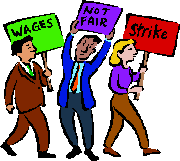Scott Marshall
People's Weekly World
The 26th Constitutional Convention of the AFL-CIO, taking place in Pittsburgh in mid September, will be a doozy.
Not since the historic 1995 convention has so much been on the line for the labor movement. The 1995 AFL-CIO convention, was the first ever contested election for top leadership of the AFL-CIO. That election signaled a critical turning point for labor. The New Voices coalition of John Sweeney, Richard Trumka and Linda Chavez Thompson marked a dramatic turn from “business” unionism towards a more fighting stance for labor.
Fourteen years later, labor is poised for even more dramatic change. In 1995 labor was coming to grips with twelve long years of Reagan/Bush led corporate attacks on working people and their unions.
In 2009 labor is finding new footing in a rapidly changing economic and political situation. Shifting gears to confront the worst economic crisis to hit workers in 80 years is no simple matter. Moving from eight years of Bush number two, a time of war, crisis, lawless government attacks on civil liberties and rights, corruption and unbridled profiteering, is hard enough. But dramatic political change can make it even rougher. Now instead of defensive fights against naked corporate power, labor has to develop strategies and broad coalitions that can actually win.
With a pro-labor president, and a greatly improved balance of power in Congress, that may sound easy. It isn’t. Actually winning means the tough work of crafting coalitions and programs that can encompass many different needs, priorities and aspirations. Real life compromises are really hard in the face of years of pent-up frustrations with the lack of progress in many different directions, on many different issues.
So the 2009 AFL-CIO convention will wrestle with making many important turns. Fortunately the convention comes at a time of unprecedented labor unity. OK. I can hear the screaming already. What’s that you say? How can anyone call today’s labor movement united? There’s a big difference between formal organizational unity and unity in action on the ground. It’s true. We have two national labor federations and numerous internal union squabbles that boggle the mind.
At the same time we have important unity in action. Think of the incredible role of a united labor movement in the 2008 elections. It showed a whole new level of labor’s independence and unity in electoral work. Think of the key issue cited in the split that formed the Change to Win federation. Today there is no significant divide in labor on the relationship of political action and organizing. There is tremendous unity in action for the Employee Free Choice Act. And no one seriously argues that labor law reform will “magically” organize millions without renewed commitment to pounding the pavement.
At a deeper level, the work that a united labor movement did to fight racism and promote working-class unity reached entirely new levels in the 2008 elections. Not in the last 40 years has labor been so totally united in backing a single candidate in the general election for president. And this time that unity was in action to elect the first African American president in our history. Labor had to, and did, take on the reflections of racism in its own ranks. Richard Trumka’s brilliant speech on racism and unity at the United Steelworkers convention in 2008 fired up union members across this county.
In addition to helping to elect a pro-labor president, labor’s efforts against racism and bigotry are also helping to build a much broader working-class unity. Much more of labor today is united around the idea that labor cannot be just the voice of its organized members. Most of labor now realizes that it must become the voice of all workers and the working class. We need only look at labor’s current energy in the fight for health care reform, for economic recovery, for aid to the unemployed, for foreclosure relief, against global warming, for fair trade, for infrastructure rebuilding, and on and on, to see a broad working-class program emerging. Even the fight for the Employee Free Choice Act is couched in terms of economic recovery and raising standards for all working families. Trumka’s recent speech to the national convention of the NAACP (Read it here) further illustrates labor’s growing ties to broader working class organizations and coalitions.
Speaking of Trumka, it looks like the Pittsburgh AFL-CIO convention will elect him as its next president along with his slate of Liz Shuler (Secretary-Treasurer) and Arlene Holt Baker (Executive Vice President). At this point there are no other declared candidates. That would be a problem if there were sharp competing visions of labor’s future as was apparent at the 1995 convention. Sure there are difference in labor about how best to mobilize and maximize labor’s strength and leadership for change. But there are few differences about fighting for labor’s growing working class program and the single slate reflects that reality.
Based on the current level of labor unity in action on the ground, the more formal organizational unity will come. The on-going work to unite Change to Win and the AFL-CIO into one federation will get a boost from the Pittsburgh convention. Labor’s unfortunate organizational splits and fights give pundits and handicappers lots to speculate on. Labor’s unity in action gives members and supporters a real foundation to build on. All in labor’s ranks and labor partisans can help make sure that the Pittsburgh convention is the important milestone it needs to be. We can focus on the fighting program that all of labor is united around. We can focus on building the leading role of labor in building coalitions and movements that can win for all working people.
From the Labor Commission of the CPUSA, updates, information, news, analysis, and organizing materials in solidarity with workers of the world.
Thursday, July 30, 2009
Subscribe to:
Post Comments (Atom)


No comments:
Post a Comment